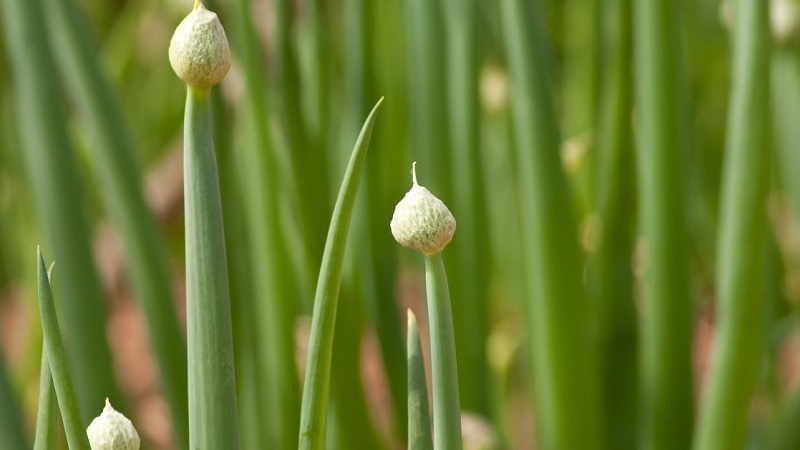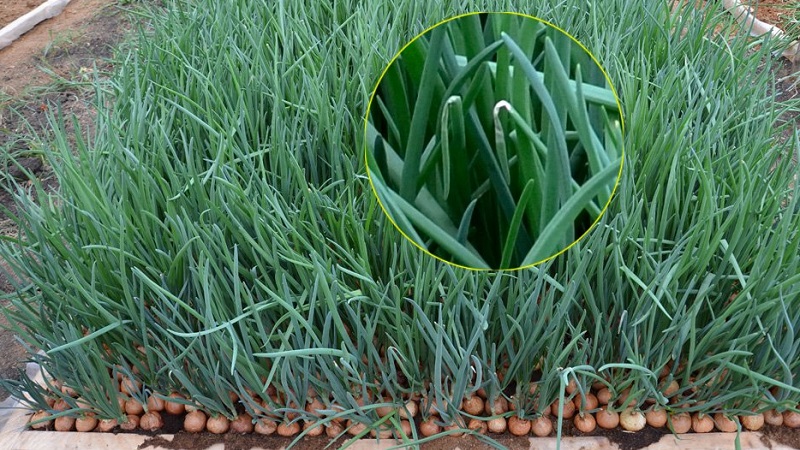What to do if there is an arrow on the bow and why it can happen
Onions are a popular crop among gardeners from different regions. It is planted both on greens and on a turnip. Among those who grow this vegetable, it is difficult to find people who have not had problems with shooting onions. This is a common occurrence, but not everyone knows how to prevent and fight it. In the article we will tell you about the popular methods and secrets of experienced gardeners.
The content of the article
Why does the bow go into the arrow
Shooting is not a disease... This is part of the onion breeding process. The plant throws out an arrow with a flower, from which seeds will then appear. This is laid down by nature, this is a natural, but undesirable process that gardeners are trying to prevent.
There are 4 main reasons for shooting:
- Improper storage of seedlings (high humidity, frequent temperature fluctuations).
- Incorrectly selected seed (more than 3 cm in diameter).
- Early planting in cold ground.
- Lack of moisture.

What is the risk of shooting
The onion arrow is an inflorescence that requires a lot of energy and minerals to grow... When a flower appears, the plant redistributes resources, depriving the turnip of a significant part of its nutrition. This can lead to insufficient growth of the rhizomes, and by the time of ripening the onion will be small. Also, after shooting, the vegetable is poorly stored and is unlikely to stay until the New Year.
How to grow a bow without arrows
Many gardeners have come to terms with the appearance of arrows on onion beds and fight them as they arise. But there are those who are trying to prevent their formation. For this, it is important to comply with a number of conditions.
Proper storage of sevka
This is one of the most important factors in preventing the growth of arrows.... There are 2 ways save seed:
- warm - at a temperature of + 17 ... + 22 ° C at home;
- cold - about + 8 ° C in the basement or caisson.
For both methods, maintaining moisture indicators is important. at the level of 65-75%. Sevok, which was stored at high humidity, is shot.

The choice of storage method depends on varieties and the size of the bulbs... Small sevok in warm home conditions can dry out, and then not rise at all. Cold storage is preferable for it. The situation is reversed with larger family varieties - they are well kept warm.
Important! Whichever storage method you choose, sort out the planting material several times during the winter and remove the rotten onions, otherwise the entire set will disappear.
Processing before planting
Preplanting Tips to Reduce Shooting Risk:
- Even at the stage of choosing a set in a store, pay attention to the appearance and husk. Onions suitable for planting must be dry, free from rot and characteristic unpleasant odors. When peeling, the scales should not completely lag behind the bulb. It is desirable that there are no already sprouted specimens.
- Before planting, the onion is warmed up. To do this, the bulbs are laid out in one layer on a board and placed on a radiator or oven. The duration of the procedure is 15-20 days.
- For planting on a turnip, select bulbs 1-2 cm in size. Larger specimens are planted separately on greens.
- The soil also requires preparation for planting. Onions grow poorly in heavy clay soil. Such a soil must be made looser and more porous. For this, sawdust or sand is added.
Attention! If you grow your own seedlings from seeds, treat them with a potassium permanganate solution before sowing.
Non-shooting varieties
From winter varieties, pay attention to:
- Centurion is a Dutch variety, early maturing, with good germination and long shelf life;
- Shakespeare - an early ripening variety with good taste.
For planting in April, choose:
- Stuttgarten - a popular variety of German origin, early maturing. Bulbs weighing up to 15 g.
- Centurion F1... This hybrid is not a winter analogue of the Centurion. Has similar characteristics.
- Red Baron... Medium early, unpretentious variety with high yield.
Proper planting care
It is important to follow the recommended onion planting dates... So that he does not go into the arrow, he is planted in a warmed-up ground. Usually the soil is ready by late April - early May. The air temperature must be at least + 15 ° C, the ground temperature - at least + 12 ° C. It is also not worth delaying, since too late planting negatively affects the yield.
Reference. Experienced gardeners advise planting onions when the first leaves appear on the birches.
Another important point in the fight against shooting is watering mode... Lack of moisture can cause this unpleasant phenomenon. In spring, onions should be watered regularly, at least 2 times a week, preferably with warm water until the soil is completely saturated. If the summer is hot, in June - the first half of July, the number of irrigations can be increased, and in the second half of the summer, reduced. About 2 weeks before harvesting, the onions stop moistening. This allows it to mature, contributes to good keeping quality.

What to do if arrows went on the bow
If the bow goes to the arrow, it is important to identify the cause in order to prevent the situation from repeating. next season. This year you will not influence the flowering process in any way. It remains only to eliminate the arrows at the initial stage of their appearance so that the plant does not waste energy and nutrients on flower development and seed ripening.
Throwing out cut peduncles is optional, they can be eaten both fresh and processed.
Attention! Do not rush to cut all the arrows off the bow. It may be worth leaving a few for the seeds to ripen.
Prevention measures
Preventive measures include:
- Warming up. The sevok is left on the battery for 2 weeks.
- Hardening. The planting material is placed underground or in a caisson, where the air temperature is from 0 to + 8 ° C, and kept there for 10 days, and then transferred to a warm place. When such hardening is not available, a quick method can be used. Before planting onions, they are immersed in cold water and dried in the sun.
- Soak. This measure not only helps to prevent shooting, but also promotes active bulb growth.
Solution for soaking onions can be prepared based on:
- Soda. Soaking time in soda solution is 15 minutes.
- Copper sulfate - 5 g per 1 liter of water.
- Salt - 1 tbsp. l. for 1 liter of water. Processing time is 3 hours.
- Potassium permanganate - 30 g per 10 liters of water.
- Birch tar - 1 tbsp. l. for 1 liter of water. The onions are dried for a day on a battery, then the husks are removed and the tops are cut off. Leave in the solution for 4 hours, stirring occasionally.
Tips from experienced gardeners
Summer residents with experience advise:
- Do not trust the purchased planting material, but grow the seedlings yourself, controlling each stage.
- For growing, choose bulbs with a diameter of 1-2 cm.
- The purchased set must be warmed up before planting.
- Plant onions in the ground when the first leaves appear on the birches.
- Cut off arrows at once. Eat the bulb of the plant with an arrow after digging it up. It will not be stored.
- Use onion arrows for food or as fertilizer, folding them in the garden after cutting.
Conclusion
Observing simple rules that have been formed over the years based on the experience of many generations of summer residents, you can reduce or completely avoid shooting onions.Store the seed in a room with a humidity level of 65-75%, treat the seed before planting and water in a timely manner.